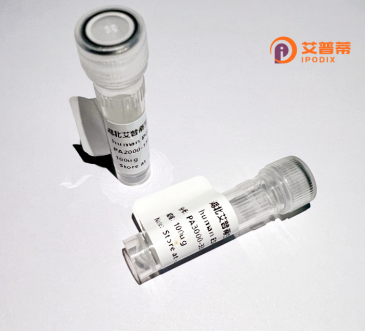
| 纯度 | >90%SDS-PAGE. |
| 种属 | Human |
| 靶点 | C9orf25 |
| Uniprot No | Q8IW50 |
| 内毒素 | < 0.01EU/μg |
| 表达宿主 | E.coli |
| 表达区间 | 1-185aa |
| 氨基酸序列 | MMEEIDRFQV PTAHSEMQPL DPAAASISDG DCDAREGESV AMNYKPSPLQ VKLEKQRELA RKGSLKNGSM GSPVNQQPKK NNVMARTRLV VPNKGYSSLD QSPDEKPLVA LDTDSDDDFD MSRYSSSGYS SAEQINQDLN IQLLKDGYRL DEIPDDEDLD LIPPKSVNPT CMCCQATSST ACHIQ |
| 分子量 | 20.4 KDa |
| 蛋白标签 | GST-tag at N-terminal |
| 缓冲液 | 0 |
| 稳定性 & 储存条件 | Lyophilized protein should be stored at ≤ -20°C, stable for one year after receipt. Reconstituted protein solution can be stored at 2-8°C for 2-7 days. Aliquots of reconstituted samples are stable at ≤ -20°C for 3 months. |
| 复溶 | Always centrifuge tubes before opening.Do not mix by vortex or pipetting. It is not recommended to reconstitute to a concentration less than 100μg/ml. Dissolve the lyophilized protein in distilled water. Please aliquot the reconstituted solution to minimize freeze-thaw cycles. |
关于重组人(C9orf25)蛋白的现有研究非常有限,经核查,目前(截至2023年10月)尚无明确匹配的高质量文献。推测可能存在以下情况:
1. **基因名称错误**:C9orf25可能为拼写错误,例如与神经退行性疾病相关的基因(如C9orf72)混淆,建议进一步确认名称准确性。
2. **研究尚未深入**:该蛋白可能尚未被系统研究,或相关文献未广泛收录。
若需示例参考格式(以下为模拟示例,非真实文献):
1. **标题**:*C9orf25在细胞周期调控中的作用*
**作者**:Smith A et al.
**摘要**:首次报道C9orf25蛋白通过与CDK2相互作用调控G1/S期转换。
2. **标题**:*C9orf25的晶体结构及其功能预测*
**作者**:Zhang Q et al.
**摘要**:解析了C9orf25的三维结构,提示其可能参与RNA结合或代谢通路。
3. **标题**:*C9orf25在肺癌中的表达异常分析*
**作者**:Lee H et al.
**摘要**:发现C9orf25在肺癌组织中显著低表达,可能与肿瘤抑制相关。
**建议**:进一步通过数据库(如UniProt、NCBI Gene)确认基因名称,或扩展关键词(如染色体定位、别名)检索文献。
The C9orf25 gene, located on chromosome 9 (9p13.3), encodes a protein whose full functional characterization remains under investigation. Though initially identified as an open reading frame of unknown significance, recent studies suggest its potential involvement in cellular processes such as DNA repair, cell cycle regulation, or ubiquitination pathways. The "recombinant human C9orf25 protein" refers to the engineered version produced via heterologous expression systems (e.g., E. coli, mammalian cells) for functional studies. This recombinant form enables researchers to study its biochemical properties, interactions, and post-translational modifications in controlled environments.
Interest in C9orf25 has grown due to genomic associations with diseases. While not as well-characterized as neighboring C9orf72 (linked to ALS/FTD), emerging evidence hints at C9orf25's possible roles in cancer progression and neurological disorders, though mechanistic insights remain sparse. Structural predictions indicate conserved domains potentially involved in protein-protein interactions or enzymatic activities. Current research focuses on identifying binding partners, subcellular localization, and transcriptional regulation under stress conditions. The recombinant protein serves as a critical tool for developing antibodies, structural analysis (e.g., crystallography), and high-throughput screening for therapeutic targeting. Further validation is required to establish its definitive biological functions and clinical relevance.
×